
Resources
Computer
Games - Government Publications - Monographs
-
Journal
Articles - Magazine Articles - Newspaper
Articles -
World
Wide Web - Unpublished

 Computer Games
Computer Games
By carefully playing games
such as those reviewed below, people can base their answers to eBrief issues
such as:
* What is a computer
game?
* What is an interactive
movie?
* Are children and/or women
in any way degraded or otherwise harmed through the violent
and/or sexual content contained within these games?
upon actual personal experience
with what they are talking about. Furthermore, many of these games
contain optional internal censorship features that demonstrate how computer
games developers have responded in regard
to concerns over controversial content in their products.
It should be noted that,
on this page, the general term of "computer games" is used to cover computer
games, video games, and interactive movies. All these alphabetically
ordered games were chosen because of their controversial nature - they
are representatives of the controversies (that lead to censorship) surrounding
computer games, even if they are not truly representative of computer gaming
as a whole.

Please be patient as
this page may take a while to load...

The
11th Hour. (1995). Designers Rob Landeros and Graeme Devine. Virgin
Interactive and Trilobyte.
In this pioneering interactive
movie on cd-rom directed by David Wheeler, the player must solve a
series of bizarre puzzles within a haunted house in order to gradually
reveal a storyline connected to the house that involves supernatural assault,
murder, and temptation spanning several decades. Movie scenes contain
adult themes, sexual references, violence, and horror. This title
is the direct ancestor of Tender Loving Care and
Point
of View, although The 11th Hour was not banned in Australia
(M 15+ rating from the Office of Film and
Literature Classification).
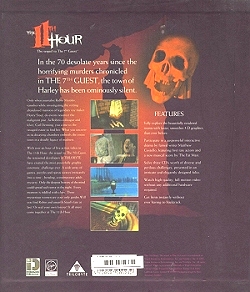
Back cover of The 11th Hour game box showing game play screens
and extensive descriptions of the game's contents.

Custer's
Revenge. (1982). [Designer unknown]. Mystique.
Often incorrectly referred
to as Custer's Last Stand by Government
proponents of computer games censorship in the mid-1990s, this is a highly
obscure and unpopular video game whose blocky cartoon graphics and stick
figures are extremely crude by today's standards. It allows the player
to take the role of a naked US Cavalry trooper from the 1800s who tries
to rape a naked Native American woman tied to a post in the desert while
her people shoot at him with arrows. There is no evidence Custer's
Revenge was ever available in Australia and any information about it
is very hard to find, but see Kent, 2000.
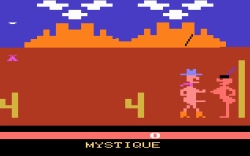
Screen shot from Custer's Revenge during game play.
A single black arrow can be seen at the top right. The two 4s are
actually supposed to be cactus plants.
Alternative
discussion of Custer's Revenge by Anthony Larme


Doom.
(1993). Designer John Romero. Id Software.
One of the pivotal and most
popular titles in computer gaming history which spawned numerous imitations,
Doom
presents a nightmarish world of space bases overrun by demons where the
player is cast in the role of a well-armed marine sent to eliminate this
menace, even to the point of entering Hell itself. All this ultra-violent,
but still relatively crude cartoonish action, is presented in first-person
perspective. Doom caused plenty of controversy worldwide for its
violence and occasional Satanic imagery, but it was not banned in Australia
(MA 15+ rating from the OFLC).
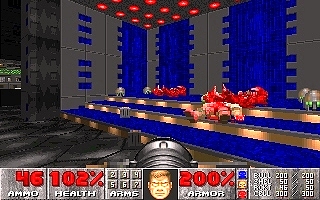
Typical example of the carnage in the aftermath of combat in Doom.
Here, the player's character has just defeated some demon-possessed human
soldiers with a rocket launcher. His current health and weapons statistics
lie in the thick horizontal bar at the bottom of the screen.
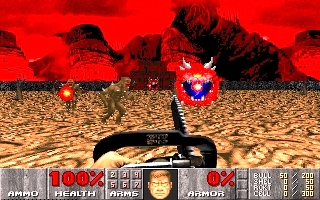
Armed only with a chainsaw, the fearless space marine battles fireball-casting
demons and imps at the entryway to Hell.

Dream
Web. (1994). Designer Neil Dodwell. Empire Software and Creative Reality.
Players of this crude cartoon-like
computer game that is viewed from an overhead perspective take on the role
of an assassin who is sent on a mission by powerful supernatural beings
to eliminate a group of people who threaten to disrupt the fabric of the
universe. One target needs to be shot while he is engaged in sex
with an unknown woman. The woman cannot be harmed and has nothing
to do with the plot, but Dream Web was nonetheless banned in Australia
for containing what the OFLC considered to be sexualised violence (i.e.
where sex and violence are deemed to be connected in some way, even if
very loosely). An appropriately modified version was briefly available
for sale in later years with an M 15+ rating.
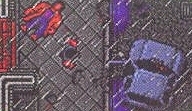

Examples of Dream Web game screens. On the left, an
evil man lies dead. At the top right of the picture on the right,
the game's cursor (in the shape of a hand) may be seen.
Alternative
discussion of Dream Web by Anthony Larme


Duke
Nukem 3D. (1996). Designers Todd Replogle and Allen H. Blum III. 3D
Realms Entertainment.
Similar in many ways to Doom,
this popular computer game caused considerable controversy for its perceived
sexual content. Such contentious depictions include scantily clad
women in red light district style occupations, and similar women who have
been tied up for breeding or food supply purposes for the evil aliens who
have overrun Earth (presumably killing almost all the men in the process).
Duke Nukem is the character controlled by the player who battles to reclaim
Earth for humanity and save as many of his fellow humans as possible.
Overblown, satirical, and often hilarious,
Duke Nukem 3D was never
meant to be taken seriously. Originally, it was allowed into Australia
only with the game's internal censorship feature
(that removed all the women) turned permanently on, but this ruling was
later overturned and it was placed on sale unmodified (MA 15+ rating from
the OFLC in both instances). See also Mackay,
1996 and Hafner, 1996.

Duke Nukem in shown on the cover of the game's instruction booklet
triumphant over his evil alien adversaries.
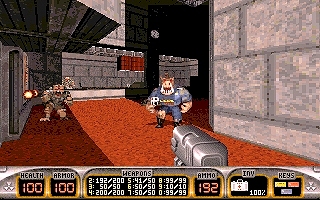
Typical example of game play in Duke Nukem 3D. Here,
Duke battles aliens which possess some of the physical features of tigers
and wart hogs.
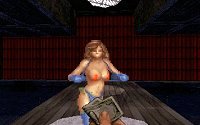

Very rarely, Duke encounters women in situations such as these.
When he does, he makes comments to show that he abhors their condition
and resolves to fight even harder to save humanity from the alien threat.
Alternative
discussion of Duke Nukem 3D by Anthony Larme


Harvester.
(1996). Designer G. P. Austin. DigiFx Interactive and Merit Studios.
Harvester is a cd-rom
based interactive movie that presents a plot of chilling extreme horror
that, according to the game's manufacturers, contains something to offend
everyone. The player takes on the role of a young man, Steve Mason,
trapped in a crazed parody of 1950s small town America that turns out to
be a virtual-reality based training ground for a cult of serial killers.
This game frequently engages in clever social commentary on matters of
sex, violence, and censorship. Although this much delayed title was
mentioned numerous times as justification for the creation of games censorship
schemes around the world, it was never put to the test in Australia as
no one submitted it for classification and thus it was never sold here.

The front cover of the Harvester game box shows the scythe-wielding
virtual reality representation of the head trainer of the cult of serial
killers. In the bottom right corner, its M 17+ rating from the USA's
ESRB may be seen.

Players who want Steve to join the cult of serial killers can have
him pass his final exam through the gruesome murder of his girlfriend.
Those who wish otherwise can see him marry her in the virtual world only
to witness his death in the real world immediately afterwards.
Alternative
discussion of Harvester by Anthony Larme

Night
Trap. (1993+). [Designer unknown]. Sega/Acclaim.
This interactive B-grade
horror movie that was released in a variety of formats for various video
and computer games systems played perhaps the largest role in the development
of a system of computer games censorship for Australia. It places
the player in the role of a protector of a group of young women dressed
in sleepwear who are being threatened with having their blood drained from
their necks by a strange race of vampires. Night Trap's realism
particularly shocked Labor Senator Margaret
Reynolds who initiated a process that led to Australia's
current games censorship system, which, incidentally, allowed this
game on sale with the second-highest possible classification (M 15+).
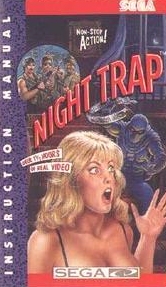
A woman in sleepwear is threatened by a vampire on the front cover
of Night Trap's instruction booklet.
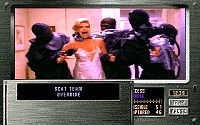
If protective measures fail, one or more women are drained of blood
by having hideous suction devices attached to their necks and activated
by the vampires.
Alternative
discussion of Night Trap by Anthony Larme


Phantasmagoria.
(1995). Designer Roberta Williams. Sierra On-Line.
As the product of one of
the computer games industry's top designers and largest companies, Phantasmagoria
was one of the most expensive cd-rom based interactive movies ever made
and one of its best-selling. Its detailed plot spans a century and
primarily involves a young woman, author Adrienne Delaney (the player's
character), surviving and partly triumphing over a haunted mansion and
her demon-possessed husband. A scene of non-interactive rape banned
this game for Australians, although no comment was made on many other
controversial scenes involving evil and horror.
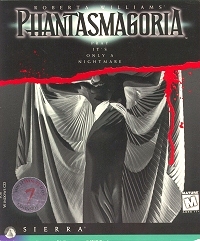
Phantasmagoria's game box - front cover. In the bottom
right corner, its M 17+ rating from the USA's ESRB may be seen. The
woman's missing head and the stream of blood foreshadows the contents of
several key scenes in the game.

Adrienne encounters yet another eerie supernatural phenomenon inside
the Phantasmagoria mansion.
Extensive
Phantasmagoria
Web
site by Anthony Larme

Phantasmagoria:
A Puzzle of Flesh. [Phantasmagoria 2] (1996). Designer Lorelei
Shannon. Sierra On-Line.
In a similar manner to its
predecessor, the cd-rom based interactive horror movie Phantasmagoria
2 caused considerable controversy for its violent and sexual content.
Its contemporary storyline contains themes of corporate greed and immorality,
psychological breakdown, and alien invasion. This time, however,
there was no sexual violence, so this title was allowed in Australia with
the game's internal censorship feature turned
on permanently (MA 15+ rating from the OFLC). See also Van
Raay, 1997a and 1997b.
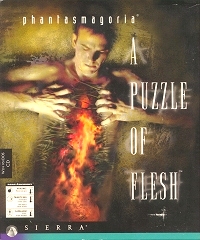
The game box for Phantasmagoria 2 shows a symbolic representation
of the player's character, tormented technical writer Curtis Craig, on
the front cover.
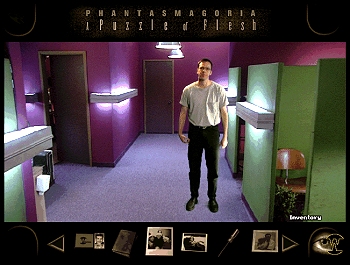
This is a typical Phantasmagoria 2 game play screen.
It depicts Curtis standing near his work cubicle at the corrupt Wyntech
chemical corporation. At the bottom of the screen lie pictorial representations
of various items he has collected so far and may use to advance the plot
upon using them at the appropriate time.
Extensive
Phantasmagoria
2 Web site by Anthony Larme

Point
of View. (2001). Designer Rob Landeros. Digital Circus. [DVD version].
Written and directed by The
11th Hour director David Wheeler,
Point of View is the most
recent example of an interactive movie and shows acting and plot at a sophisticated,
mature level rarely seen in gaming. Its complex storyline that encompasses
numerous adult themes centres on a young, introverted, mysterious artist
and ex-model, Jane Bole, who gradually regains her self-confidence in matters
of romance as she comes to terms with a dark event in her past. Interactivity
primarily involves the player periodically answering multiple-choice questions
based on one's personal interpretation of the movie scenes that have just
been shown. Based on these responses, future scenes are modified,
substituted, or omitted entirely. This title has not yet been rated
as either a film or a computer game in Australia, but would likely be banned
in its upcoming cd-rom version as that would be considered a computer game
and thus its two non-interactive inexplicit consensual sex scenes be deemed
totally unacceptable.

The enigmatic yet sympathetic artist/model Jane Bole.
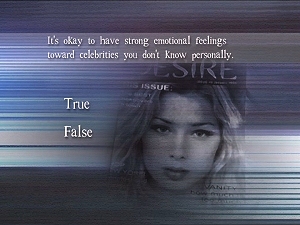
One of dozens of multiple-choice questions within Point of View.
Extensive
Point
of View Web site by Anthony Larme

Strip
Poker. (1995). [Designer unknown]. Artworx.
Strip Poker is based
on the real-world card game of the same name and presents a scenario where
the losing participants remove articles of their clothing. Such participants
are usually in the form of a series of clear, static pictures of young
women in various states of undress. The real-world game player, if
visually represented at all, is usually just a crude stick figure.
All non-educational nudity is banned in games sold in Australia, so this
game (and its variants) is likewise banned.

Screen shot from Strip Poker during game play. The
black and red Censored sign has been added by the author of this page in
the interests of complying with Australia's Internet censorship regulations.
It hides real female nudity. At the bottom left of the picture, the
player is represented by a crude stick figure. The current hand of
cards held by the player lies immediately to the right.
Alternative
discussion of Strip Poker by Anthony Larme

Tender
Loving Care. (1998). Designer Rob Landeros. Aftermath Media. [cd-rom
version].
Yet another interactive movie
directed by David Wheeler, Tender Loving Care was banned in Australia
in its cd-rom version as it was considered a computer game in which non-educational
nudity is not permitted. Such controversial depictions are part of
a complex thriller plot in which an evil psychiatric nurse, Kathryn Randolph,
comes to stay with a traumatised young married couple, Michael and Allison
Overton, who are trying to recover from the death of their daughter in
a recent car accident. She sexually teases the husband while psychologically
dominating his wife until the murderous finale. As with Point
of View, periodic questions asked of the player have some influence
in determining the outcome.

Kathryn Randolph looks up from her laptop computer to speak with
Michael Overton in the cd-rom version of Tender Loving Care.

Tender
Loving Care. (1999). Designer Rob Landeros. Aftermath Media. [DVD version].
An additional entry is required
for this title as the DVD version was allowed for sale in Australia as
a film with an MA 15+ film rating. It is exactly the same
as the banned cd-rom version, with the exception that all movie scenes
are much clearer owing to the visual benefits of the DVD medium.
This decision exposed glaring inconsistencies in Australia's overall censorship
system - part of the reason the current review
of the Games Classification Guidelines is taking place.

Michael comforts his wife, Allison, at the conclusion to one possible
ending to Tender Loving Care.

Voyeur.
(1994). Designer David Riordan. Interplay.
While using a video camera
to spy on the home of a controversial potential US Presidential candidate
in this cd-rom based interactive movie, the player might encounter a scene
where the man's daughter accuses him of sexually molesting her as a child.
Sexually explicit language is not permitted in games sold in Australia,
so Voyeur was banned. Other non-interactive scenes in this
title that involve non-explicit, brief instances of kinky consensual sexual
games did not receive any comment.
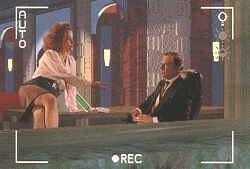
Confrontation time in Voyeur.
Alternative
discussion of Voyeur by Anthony Larme

 Anthony
Larme's Websites Main Page
Anthony
Larme's Websites Main Page

